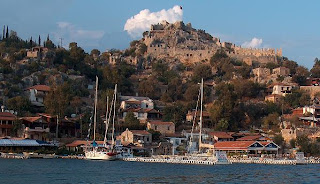When I first heard of Turkish Delight in "The Lion, the Witch, and the Wardrobe," I thought it was some made up confection that the White Witch offered to unsuspecting children. It was only years later that I actually saw a dusty box of Turkish Delight in an ethnic food mart...but, as it didn't involve chocolate, I wasn't too interested, I must admit!
However, I'm intrigued as to what Turkish Delight actually is....candy? gummy? super sweet? nutty? fruity? gelatinous? What the heck is it?
 |
| Turkish Delight |
Turkish Delight dates back to the Ottoman Empire (I'll definitely be talking about them in a future post) and is also known by it's Turkish name - "lokum". Supposedly a sultan in the 1700s was tired of hard candies and demanded a new dessert alternative. A man named Bekir Effendi, who moved to Istanbul from the coast of the Black Sea, took up the challenge and used honey and molasses as sweetners, water and flour as thickener, and rosewater for flavor. He mixed the ingredients together, heated them up, and then poured the concoction in a pan slicked with almond oil to cool. He sprinkled it with powdered sugar, cut it into bite-sized morsels, and began a Turkish sensation!
 |
| Ali Muhiddin Haci Bekir Confectioners shop |
Bekir opened a
shop has been in continuous operation in the Old City district of Istanbul for over 200 years. They have expanded to include several additional storefronts where they serve numerous Turkish sweets, as well as Turkish Delight in a variety of flavors: plain, rose, pistachio, hazelnut, walnut, almond, coconut and almond, cream, cream with cinnamon, mastic, mint, sourcherry, lemon, strawberry, orange, apricot, date, ginger, clove and coffee.
Turks are notorious for having a sweet tooth, and this is an incredibly popular treat. The confection is made of starch and sugar and is often flavored with rosewater, mastic (tree resin with a bitter/piney flavor), and lemon. The consistency is somewhat jelly like, and can be sticky at times. The candy is cut into cubes which are dusted with icing sugar or copra (coconut) and sometimes contain pieces of nuts like walnut, pistachio and hazelnut.
I just tried to find some Turkish restaurants in San Diego to no avail, but I did find a few Mediterranean shops and restaurants that have fresh made Turkish Delight and Turkish coffee on the menu - I'll check them out and update you all soon!





























